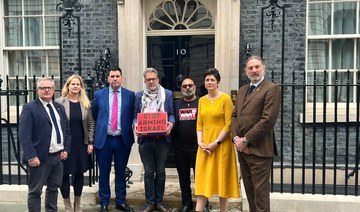COX BAZAR: Gunmen in Bangladesh have killed a teacher and a student in a Rohingya refugee camp for refusing to return to Myanmar to fight, their parents said Thursday.
Hundreds of Rohingya boys and young men have been seized from refugee camps in Bangladesh, where they had sought safety after Myanmar’s military drove about 750,000 members of the persecuted Muslim minority out of the country in 2017.
Now Rohingya militants working with the Myanmar junta are recruiting the refugees, according to camp residents, UN reports and analysts.
The militants say their fellow Rohingya need to ally with Myanmar’s army — the same forces who drove them into exile — to face a common enemy in another Myanmar rebel force, the Arakan Army (AA).
Police said the two men, student Nur Absar, 22, and teacher Nur Faisal, 21, were killed by “unknown assailants” in Kutupalong camp in Bangladesh’s Cox’s Bazar district.
“One died on the spot, another died in hospital,” said Arefin Jewel, a police spokesman in Kutupalong.
“We are investigating whether it is a case of forced recruitment.”
But Faisal’s father blamed the Rohingya Solidarity Organization (RSO).
“The RSO went to my son’s school and wanted to recruit him,” Zakir Ahmed, 45, told AFP. “My son refused.”
Ahmed said his son had also been working as a community guard to stop the gunmen who prowled the camps to press-gang youths.
“He was also working as a night guard to save other young Rohingya from forced recruitment by armed groups,” he said.
“RSO gunmen shot them. RSO killed my son.”
Aman Ullah, 40, the father of student Nur Absar, also blamed the RSO.
“They tried to recruit him,” Ullah said. “They have become the name of terror here.”
Thomas Kean from the International Crisis Group think-tank told AFP the “tragic killings only highlight the growing threat that refugees face from Rohingya armed groups.”
“For years now the groups have largely been allowed to operate with impunity, and refugees are really at breaking point,” he added.
Kean said his research showed that since March “thousands of refugees” had been recruited by Rohingya armed groups and sent to Myanmar.
The Rohingya fighters are battling alongside Myanmar’s regular army in Rakhine State.
They are fighting forces including the AA, which says it wants greater autonomy for the ethnic Rakhine population in the state, which is also home to around 600,000 Rohingya.
This month the AA took control of Buthidaung, a Rohingya-majority town not far from Bangladesh.
Several Rohingya diaspora groups claimed that fighters forced Rohingya to flee, then looted and burned their homes — claims the AA called “propaganda.”
According to a report by the United Nations refugee agency seen by AFP, at least 1,870 refugees — more than a quarter of them children or youths — were recruited into the armed groups during a two-month period between March and May.
More than three-quarters were taken by force, the UN report said, including by “abduction, kidnapping and coercion.”
The UN children’s fund said it was “appalled” by the attack.
“UNICEF strongly condemns any attack against schools... which must always be a safe space for children, and for the staff delivering this essential service,” country chief Sheldon Yett said.




















